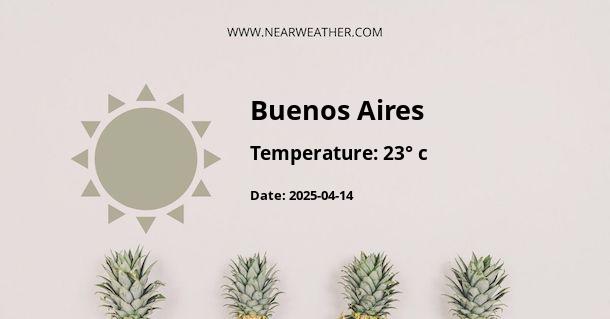Climate and Weather in Buenos Aires, Argentina
Buenos Aires, the capital city of Argentina, is known for its vibrant culture, rich history, and diverse neighborhoods. When it comes to the climate, Buenos Aires experiences a temperate climate with four distinct seasons. Understanding the weather patterns throughout the year can help visitors and residents better prepare for their time in this beautiful city.
Annual Weather Overview
Let's take a closer look at the weather in Buenos Aires throughout the year:
| Month | High (°F) | Low (°F) | Rainfall (in) |
|---|---|---|---|
| January | 83 | 68 | 4.3 |
| February | 81 | 66 | 4.5 |
| March | 79 | 64 | 5.1 |
| April | 74 | 59 | 3.3 |
| May | 68 | 53 | 3.1 |
| June | 62 | 48 | 2.5 |
| July | 61 | 46 | 2.8 |
| August | 64 | 48 | 3.0 |
| September | 68 | 52 | 3.5 |
| October | 73 | 57 | 4.2 |
| November | 77 | 61 | 4.7 |
| December | 81 | 65 | 4.3 |
As shown in the table above, the summer months of January and February are the warmest in Buenos Aires, with average high temperatures reaching the low 80s (°F) and lows in the mid-60s (°F). The winter months of June and July are the coolest, with average high temperatures in the low 60s (°F) and lows in the mid-40s (°F). Throughout the year, the city experiences a moderate amount of rainfall, with the wettest months being November through March.
Seasonal Weather Patterns
Buenos Aires experiences four distinct seasons, each with its own unique weather patterns:
Spring (September to November)
- Spring in Buenos Aires brings mild temperatures, with highs ranging from the upper 60s to the mid-70s (°F).
- This season sees an increase in rainfall, so visitors should be prepared for occasional showers.
Summer (December to February)
- Summer is the hottest and most humid season in Buenos Aires, with high temperatures reaching the low 80s (°F).
- Thunderstorms are common during the summer months, bringing heavy rainfall and cooler temperatures.
Fall (March to May)
- Temperatures begin to cool during the fall months, with highs in the 60s and 70s (°F).
- Rainfall continues to decrease as the season progresses, transitioning into drier weather.
Winter (June to August)
- Winter in Buenos Aires is characterized by cool temperatures, with highs in the 50s and 60s (°F) and chilly evenings.
- While winters are generally mild, cold fronts from the south can bring brief periods of colder weather.
Best Time to Visit
Based on the weather patterns, the best time to visit Buenos Aires largely depends on personal preferences. For those who enjoy warm weather and outdoor activities, the summer months from December to February are ideal. However, if you prefer milder temperatures and want to avoid the peak tourist season, the spring and fall months are excellent choices.
Conclusion
Overall, Buenos Aires offers a pleasant climate throughout the year, with each season bringing its own unique charm. Whether you're exploring the city's historic sites, enjoying the local cuisine, or taking in a tango performance, understanding the weather patterns can enhance your experience in this captivating city.
A - Buenos Aires's Latitude is -5.260830 & Longitude is -79.964172.
A - Weather in Buenos Aires is 20° today.
A - Climate Conditions in Buenos Aires shows overcast clouds today.
A - Humidity in Buenos Aires is 77% today.
A - Wind speed in Buenos Aires is 2.38 km/h, flowing at 209° wind direction. today.
